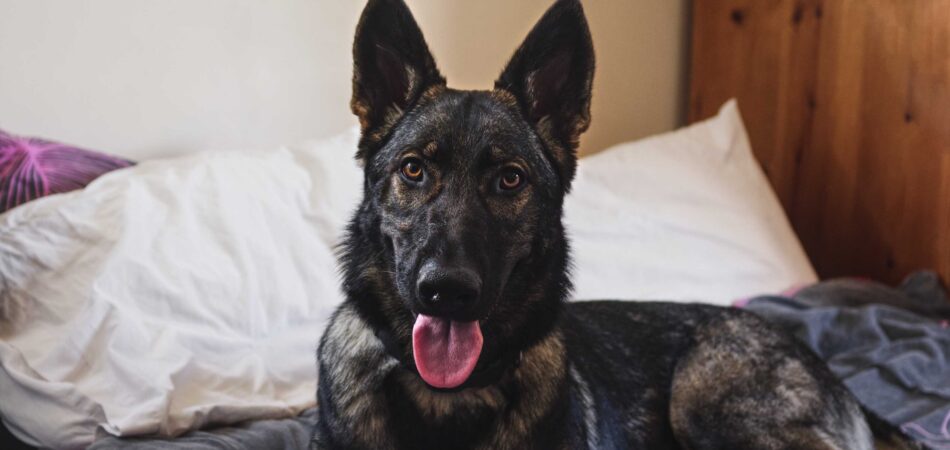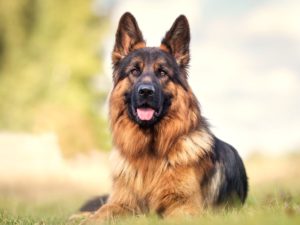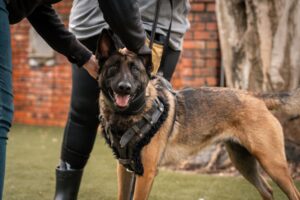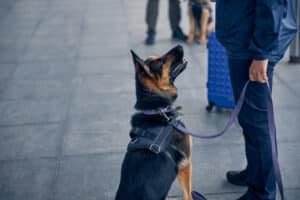






People often mix up the Belgian Malinois and the German Shepherd—and honestly, it’s easy to see why. Same sharp ears. Same intense gaze. Same powerful build. Same commanding presence.
And make no mistake—neither is a dog you’d want to underestimate. Both are intelligent, highly trainable, disciplined, and incredibly strong. Both have earned their stripes with military units, police departments, and elite security teams worldwide.
And according to the American Kennel Club, both consistently rank among the top 10 most popular and protective dog breeds in the U.S.
But here’s where we pause….. Similar doesn’t mean the same.
Choosing between a Belgian Malinois and a German Shepherd isn’t a matter of preference. It’s a matter of alignment with your needs, lifestyle, personality, and readiness to lead something with raw, unfiltered capability.
Both breeds can protect you. But only one will truly match you. And that? That’s the difference worth exploring.
Let’s get into it.
 The Belgian Malinois is fire—relentless, intense, and always ready to ignite. They’re never idle. Never casual. They exist in a state of perpetual motion, always seeking their next task.
The Belgian Malinois is fire—relentless, intense, and always ready to ignite. They’re never idle. Never casual. They exist in a state of perpetual motion, always seeking their next task.
You don’t “own” a Malinois. You commit to them. Fully. Their world revolves around purpose, precision, and pressure. They are wired to solve problems. They don’t just need stimulation—they crave it. And if you’re not ahead of them, they’ll take the lead.
Now, enter the German Shepherd.
The Shepherd is the furnace—steady, powerful, and consistent. The drive is still there, but there’s more control, more emotional flexibility.
They adapt to structure but aren’t undone by its absence. They’re more tolerant of your off-days, more patient with people, and a little forgiving. That doesn’t mean they’re easier. It just means they offer you more grace.
The German Shepherd is just more balanced.
Both breeds are insanely smart. No question. But the way they learn? That’s where the divide happens.
Malinois will pick things up quickly, but if your training lacks clarity, consistency, and challenge, they’ll start running their own playbook. They are not waiting for your permission. They’re calculating the next three moves while you’re still stuck repeating a command.
Training them is more about negotiation. You have to be respectable in their eyes. That means structured, confident, assertive—but not reactive. They don’t respond to fear. They respond to standards. Your leadership has to be earned, not demanded.
German Shepherds, on the other hand, are often more handler-oriented. They aim to please. They’re more relational. They’ll stick with you even when you fumble.
But let’s not sugarcoat it—without consistent engagement, they will develop anxiety, behavioral issues, or worse… apathy. And an apathetic protection dog is a liability.
Neither breed is “born” protective in the way most people think. Yes, there is raw protective instinct. But, unshaped, it leads to aggression, anxiety, unpredictability—the kind of behavior that causes more harm than good.
True protection dogs are made through purposeful breeding, exposure, training, environmental shaping, and trust-building.
That said, Malinois tend to have a higher prey and drive threshold. Their agility and alertness make them a favorite for high-stakes work. Think Navy SEAL teams, elite K9 units, special ops.
But that power comes at a cost—without purpose, they self-destruct. And when they spiral, it’s not pretty.
German Shepherds have a more balanced protective instinct. They read environments with a little more emotional context.
This makes them ideal for family protection—loyal and alert when it counts, but calm enough to relax around kids, guests, and the everyday chaos of home life.
But again, this all comes down to training.
The truth? If you don’t have the time, skill, or resources to invest in building those instincts the right way, neither breed will “naturally” save the day.
Things get personal here. Do you want a dog who needs three hours of intense daily stimulation just to stay sane? Can you handle a lifestyle that requires structured routines, high engagement, and almost military-level discipline?
Because that’s what the Malinois demands, not asks—demands. They are elite athletes. Born to move. Born to serve. Born to work.
Leave them alone for too long, and they’ll turn your drywall into confetti. Give them inconsistent training, and they’ll turn into a risk.
The German Shepherd, while still requiring structure and challenge, has more emotional bandwidth. They can do well in high-performance roles and adapt to being a loyal home protector—as long as you’re consistent.
They still need work and stimulation. But they don’t crumble if the schedule shifts for a day or two.
The Malinois fits best with experienced handlers, trainers, or those deeply embedded in a lifestyle that revolves around training and canine performance.
The Malinois bonds with laser intensity. When they choose you, that’s it. You become their mission. Their world narrows to a single point of focus—you.
But this kind of loyalty is complicated. It can feel like an obsession. They’re not great at “sharing” affection.
In many cases, they’re a one-handler dog—hyper-attuned to a single person, often to the exclusion of everyone else.
The German Shepherd’s bond is broader—but no less intense.
They’re loyal to the family unit. Mom, Dad, kids—everyone gets a piece of their heart. They may still have one “primary” person, but they’re not as possessive about it. They love hard, and they love wide.
There’s a softness in a Shepherd’s bond. A sense of calm. This makes Shepherds a better fit for households with multiple people, kids, or guests. They adapt. They include.
Whether you’ve got a Belgian Malinois or a German Shepherd, their bodies are a high-performance system. Not just muscle and teeth—but focus, and stamina.
And if you’re training them regularly (as you should be), expect to feed them like an ultra-marathoner.
What they need:
You’ll also want to split their meals (morning/evening) to maintain energy without overloading their digestive system before activity.
A few golden rules:
Their ability to defend, obey, and endure depends on what’s in that bowl.
Both breeds are prone to breed-specific issues.

But their energy levels? Through the roof. That kind of intensity—especially if not paired with proper warm-ups, cool-downs, and recovery—can lead to injury over time (muscle strains, joint stress, and impact injuries).
German Shepherds, on the other hand, are infamous for hip and elbow dysplasia—especially in dogs from unethical breeding lines.
Arthritis, chronic pain, and reduced mobility often follow. This is why health testing and ethical breeding aren’t optional—they’re critical.
When demand outpaces discernment, both breeds suffer.
Temperament suffers. Lifespans shorten. Health issues skyrocket. Which is why working with a breeder who values health, purpose, and quality over volume is non-negotiable.
If you’re looking for a budget-friendly bargain dog, this isn’t it. This is an investment. And not just of money—but of time, presence, and care.
Beyond joint issues, the German Shepherd has a few serious health concerns worth noting:
A digestive disorder where the pancreas doesn’t produce the enzymes needed to break down food. Fortunately, it’s manageable—with lifelong enzyme supplements added to meals.
A life-threatening condition where the stomach fills with air and twists. It can happen suddenly—and it’s deadly without immediate treatment.
Researchers believe loose ligaments and deep-chested anatomy make GSDs especially vulnerable.
A progressive spinal condition that can lead to hind leg paralysis. There’s no cure—but there is a genetic test for the DM gene. A good breeder will already be screening for it. Make sure you ask.
The Malinois tends to have fewer major genetic issues, but they’re not immune.
A degenerative eye condition that leads to blindness. Night blindness around age 3–5 is usually the first clue. DNA tests can identify carriers, so talk to your breeder about screening protocols.
This one’s crucial. Malinois have a genetic mutation that affects how their brain metabolizes anesthesia. Combine that with their naturally low body fat, and the risk of overdose becomes very real. Always work with a vet who understands this breed.
So, what’s the lifespan?
On average:
But again—longevity isn’t luck. It’s the result of ethical breeding, preventive health care, smart conditioning, and daily attention.
Let’s not pretend looks don’t matter—especially when your dog’s posture alone can prevent a threat.
Belgian Malinois are sleek, agile, and kinetic. They move like coiled springs—always ready to launch.
They typically weigh 60–80 pounds and stand about 22–26 inches tall at the shoulder.
They may be more compact than their German counterparts, but their power-to-weight ratio is outrageous. Pound for pound, a Malinois will outrun, outclimb, and outmaneuver most dogs in the protection world.
What stands out most? That gaze. Intense. Calculating. Even in rest, they look like they’re planning something.
Their coat is short, fawn or mahogany in color, usually with a black mask, giving them a sharp, almost severe expression.
German Shepherds, by contrast, have a more substantial, grounded build with an imposing “classic protector” look.
They weigh in around 65–90 pounds, with a height ranging from 22–26 inches, like the Malinois, but they carry their weight differently. More bulk. More bone.
Their double coat is thicker, often medium-to-long, with that iconic black-and-tan coloration (though sable, black, and even white GSDs exist too). They carry themselves with a calm, commanding energy—less about speed, more about posture and presence.
And when a Shepherd squares off and locks eyes, there’s no mistaking it—you’re in the company of something ancient, watchful, and noble.

These aren’t lap dogs waiting for instructions. They were built to work, protect, decide, and act. And if you’re not providing clear, consistent direction? They’ll do it for you.
Let’s start with the Malinois.
This breed doesn’t just test boundaries—they study them. Every look, every silence, every hesitation from you… They’re clocking it. And if you’re not stepping up? They’ll take charge without hesitation.
If you have other pets, the Malinois will size up the entire house and appoint itself guardian-in-chief. Not out of rebellion—but instinct. It’s hardwired for protection and control.
Now the German Shepherd.
Shepherds are confident, composed, and assertive in quieter ways. They won’t always challenge you head-on—but they will take charge if they sense a leadership vacuum.
They’re pack-oriented, deeply loyal, and wired for structure. If you’re not setting that structure, they’ll build their own…..
So, what does dominance mean in this context?
It means you must earn their respect—not with fear, but with consistency, boundaries, and clarity. These dogs don’t need you to be harsh. But they do need you to be immovable in your expectations. Calm. Firm. Present.
Let’s make one thing clear:
If you’re not ready to be a leader, neither breed is for you. Both breeds are powerful, commanding, and smart enough to run circles around weak-willed handlers. You don’t “own” them. You partner with them.
Measured in pounds per square inch (psi), bite force gives you a sense of how much pressure a dog can exert when clamping down.
It’s not the only factor in protection (strategy, training, and control all matter more), but in a worst-case scenario? It’s a number that starts to matter very quickly.
| Dog Breed | Bite Force (psi) |
|---|---|
| German Shepherd | 238 |
| Belgian Malinois | 200 |
So, yes—the German Shepherd edges out the Malinois here. By about 38 psi. That’s not a minor difference. It’s the kind of edge that could matter if your dog ever had to hold someone down or neutralize a threat in a real-world scenario.
But—and this is crucial—bite force isn’t the whole story.
The Belgian Malinois may hit lighter, but they hit faster. The German Shepherd? They hit with weight.
Both dogs are known for their precision. They target. They lock. They follow through. Their bite is part of a sequence that’s been drilled and perfected.
And if you’re training for real-world threats, you’re not just measuring psi—you’re evaluating control under pressure. And that comes down to training, not just teeth.
Let’s get personal again—because this decision isn’t just about the dog. It’s about you.
Can you commit to something—even when it’s inconvenient? Are you more inspired by intensity or steadiness?
If you crave speed, stamina, and relentless drive—the Malinois is your match. But let’s be clear: this isn’t a part-time commitment. If your life can’t support that pace, it’s a disservice to both of you.
If you want a loyal, level-headed partner, the German Shepherd is ready to meet you there. But don’t confuse grounded with low-maintenance. This breed still demands your best—daily.
And no, you don’t get to outsource this to a trainer and call it a day.
These dogs will reflect your habits. Mirror your consistency. Match your intensity. Or lack thereof.
Ready to meet your match?
Visit Vanguard Protection Dogs to view available dogs, explore upcoming placements, or begin the process of securing your perfect match.
We select, train, and place protectors—strategically, responsibly, and with zero shortcuts.
Every Malinois and Shepherd that leaves our facility:
PLUS:
Our process starts with YOU—not the dog.
We’ll evaluate your lifestyle, experience level, protection needs, expectations, and goals. Because the right dog for someone else might be completely wrong for you. And we refuse to set either of you up for failure.
We place only a few dogs per quarter. Not because we can’t train more—but because we won’t compromise our standards.
That’s why our waiting list exists. That’s why our prices reflect the value we deliver.
If you’re ready for a protection partner that’s worth every penny….If you’re committed to becoming the handler your dog deserves…
Let’s talk. Schedule your consultation today.